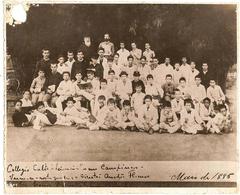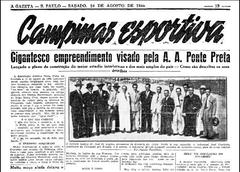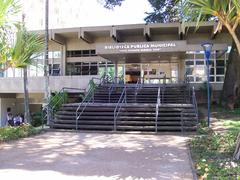Edifício Santana Campinas: Comprehensive Visiting Guide to Hours, Tickets, and Historical Significance
Date: 03/07/2025
Introduction
Nestled at the heart of Campinas, Brazil, Edifício Santana stands as a testament to the city’s architectural innovation, rich historical heritage, and dynamic urban evolution. As the city’s first skyscraper and a celebrated Art Deco icon, Edifício Santana not only marks a pivotal moment in Campinas’ modernization but also connects visitors to a constellation of nearby cultural and historical landmarks. This guide provides all the essential information for visitors—including opening hours, ticket policies, accessibility, and practical tips—while exploring the building’s architectural features, preservation status, and its role in Campinas’ broader urban and cultural landscape (audiala.com; pt.concerty.com; Wikipedia; trek.zone; illustrarch.com).
Historical Background and Urban Development
Founded in 1774, Campinas rapidly transformed from a rural outpost into a prosperous urban center, catalyzed by the 19th-century coffee boom and the arrival of the railway in 1867. This economic prosperity laid the groundwork for the construction of elegant public buildings and mansions, and eventually, modern high-rises. Edifício Santana, completed in the 1930s, epitomized this transition—heralding the city’s move towards vertical urbanism and reflecting the city’s socioeconomic dynamism (audiala.com; pt.concerty.com).
Architectural and Cultural Significance
Edifício Santana’s architectural style is a distinguished example of Art Deco, with geometric motifs, curved balconies, and “Copacabana” style windows featuring rolling shutters and pivoting panes (Wikipedia). Its reinforced concrete frame was innovative for the time, and its symmetrical, vertical façade remains a favorite among architecture enthusiasts. The building’s central location at Rua Barão de Jaguara and Rua César Bierrenbach cements its prominence in Campinas’ historic downtown.
Notably, Edifício Santana has been officially listed as a protected heritage site since 2011, recognized by the Campinas Council for the Defense of Architectural and Cultural Heritage (Condepacc), alongside other Art Deco buildings—a testament to its enduring historical and architectural value (Wikipedia; illustrarch.com).
Building Layout and Accessibility
The six-story Edifício Santana is a mixed-use structure:
- Ground Floor: Seven commercial retail spaces, open during standard business hours.
- Upper Floors: Hotel accommodations and commercial offices.
- Access: A single elevator serves all floors, providing basic accessibility, though some older features may not fully meet modern standards.
The main entrance, highlighted by Art Deco symmetry, offers direct access to both retail and hotel areas. The building’s location is within walking distance of major city landmarks, public transit, and amenities, with street parking and public garages available nearby (Wikipedia).
Visiting Edifício Santana: Hours, Tickets, and Entry
- Exterior Viewing: Available at any time—there are no restrictions for viewing or photographing the façade from public sidewalks.
- Retail Spaces: Typically open Monday to Saturday, 9:00 AM to 6:00 PM.
- Hotel and Offices: Access is limited to guests and clients; there is no formal museum or exhibition area.
- Entry Fee: No fee is required for exterior viewing or visiting ground-floor shops.
- Guided Tours: Currently, there are no formal guided tours or exhibitions inside Edifício Santana.
For visitors with mobility needs, the elevator provides access to all floors, but it is advisable to contact the hotel or office management in advance for specific accessibility arrangements.
Preservation and Heritage Management
Edifício Santana is protected by local and state heritage councils, including CONDEPHAAT, which oversee the conservation of São Paulo’s railway and Art Deco heritage (Campinas Railway Heritage). While the structure remains sound, ongoing preservation efforts address common challenges such as water infiltration and masonry repairs. Adaptive reuse initiatives and community engagement are central to maintaining the building’s status as a living urban landmark (illustrarch.com).
Nearby Historical and Cultural Landmarks
Edifício Santana’s prime downtown location places it near several of Campinas’ most significant sites:
- Metropolitan Cathedral of Campinas: A neo-Gothic church with stained glass and woodwork (Triplyzer).
- Mercado Municipal: A bustling market with local produce and artisanal goods (ExploreCity).
- Praça José Bonifácio: A vibrant local square.
- Museu da Imagem e do Som: Dedicated to audiovisual heritage (trek.zone).
- Bosque dos Jequitibás: An urban park with a small zoo and natural history museum (DoinBrazil).
These sites are easily accessible on foot, making Edifício Santana an ideal starting point for exploring the city’s cultural core.
Practical Visitor Tips
- Photography: Best undertaken during morning or late afternoon for dramatic façade lighting. Exterior photography is permitted; interior photography requires tenant permission.
- Safety: Downtown Campinas is generally safe during the day; exercise standard urban precautions, especially after dark (Hikersbay).
- Transportation: The area is well-served by buses, taxis, and ride-share services. Parking can be limited during peak hours.
- Dining: The vicinity offers diverse culinary options, from traditional Brazilian to international fare. The Cambuí neighborhood nearby is renowned for nightlife and restaurants.
Best Time to Visit
Campinas experiences a subtropical climate. The period from December to March is the warmest and most vibrant, coinciding with festivals and outdoor events (TravellersWorldwide). For milder weather and fewer crowds, July and August are recommended. If attending major events—like the Coffee Dinner & Summit in July 2025—book accommodations early (RevistaCultivar).
Health, Safety, and Local Customs
- Healthcare: Campinas provides excellent medical facilities; travel insurance is recommended (Hikersbay).
- Language: Portuguese is the official language. English is spoken in many hotels and tourist areas.
- Tipping: A 10–12% service charge is customary in restaurants; small gratuities for hotel staff and taxi drivers are appreciated.
Responsible Tourism
As a protected heritage site, visitors are encouraged to respect Edifício Santana’s historical character, avoid damaging features, and be considerate of tenants and ongoing business activities. Supporting local businesses and cultural organizations further bolsters preservation initiatives (Wikipedia; illustrarch.com).
Frequently Asked Questions (FAQ)
Q: What are the visiting hours for Edifício Santana?
A: The exterior can be viewed at any time. Ground-floor shops are open 9:00 AM–6:00 PM, Monday to Saturday.
Q: Is there an entry fee?
A: No, there is no charge for exterior viewing or visiting the shops.
Q: Are there guided tours available?
A: No formal tours are currently offered inside Edifício Santana.
Q: Is the building accessible for visitors with disabilities?
A: There is elevator access to all floors, but some features may not fully meet modern standards. Contact management in advance for specific needs.
Q: Can I take photos inside?
A: Exterior photography from public areas is permitted. For interior shots, obtain permission from the relevant tenants.
Q: What other historical sites are nearby?
A: Notable nearby sites include the Metropolitan Cathedral, Mercado Municipal, Museu da Imagem e do Som, and Bosque dos Jequitibás.
Visuals and Media
High-quality images of Edifício Santana’s façade and architectural features are available through official tourism websites and the Audiala app. An interactive map of the location and nearby attractions can help optimize your visit.
Related Resources
Conclusion
Edifício Santana endures as a living chronicle of Campinas’ transformation, bridging its coffee-driven past, industrial expansion, and modern identity as a technological and cultural hub. Whether you are an architecture enthusiast, history lover, or casual traveler, a visit to Edifício Santana offers a unique glimpse into the layers of Campinas’ urban evolution.
Before visiting, verify current hours and event schedules via official channels. Utilize resources like the Audiala app and local tourism platforms for up-to-date information. Your engagement supports preservation efforts and ensures that Edifício Santana remains a cherished symbol for generations to come (audiala.com; pt.concerty.com; Wikipedia; trek.zone; illustrarch.com).
References
- Edifício Santana in Campinas: Visiting Hours, Tickets, and Nearby Historical Sites, 2025, Audiala
- Campinas - Area Overview, 2025, PT.Concerty
- Edifício Santana, Wikipedia, 2025
- Campinas City Guide, Trek.zone, 2025
- Campinas Railway Heritage, Academia.edu, 2025
- The Role of Architecture in Shaping Cultural Identity, Illustrarch, 2025
- Campinas Tourist Information, Hikersbay, 2025
- Campinas Cultural Events, RevistaCultivar, 2025





